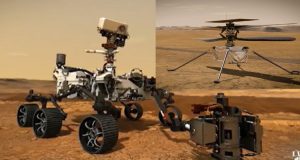
RNS: NASA successfully launched its Mars 2020 Perseverance rover using an Atlas V rocket from Florida’s Cape Canaveral on Thursday (30 July) to find evidence of ancient, microbiotic life on Mars.
Perseverance was loaded atop a United Launch Alliance (ULA) Atlas V rocket, which had a good liftoff and deployed its second stage, which put the spacecraft into a parking orbit as it readies to depart on its trip toward Mars, which will see it arrive in February 2021, it said in an official statement.
Once at Mars, the lander vehicle will take Perseverance down to the planet’s surface on February 18, 2021, to a target landing zone found in what’s known as Jezero Crater. This location on Mars was once a lake, long ago when the atmosphere on Mars was quite different than the dry, dusty and cold environment we know today. This has been chosen specifically because it’s a prime spot for finding any evidence of microbiological life that might exist, as it contains one of the best-preserved deposits of a river delta on Mars.
Perseverance is loaded with seven scientific instruments to explore the Martian landscape and assess whether the planet was ever able to sustain life.
‘Perseverance’ rover is a six-wheeled robot that has a tiny box-shaped helicopter named ‘Ingenuity’ for deploying it on Mars. If the copter manages to successfully hover above the Martian terrain, it’ll be the first time that a human-made vehicle has ever flown on another world — and it could open up a whole new way of exploring the Solar System in the future.
“For the first time ever, we’re going to fly a helicopter on another planet,” NASA Administrator Jim Bridenstine said in a news briefing, adding that future missions to other worlds could use similar helicopters as airborne scouts.
The rover will attempt for the first time to bring Martian rock samples back to Earth, collecting materials in cigar-sized capsules and leaving them scattered on the surface, which will then be retrieved by a future “fetch” rover. That conceptual rover is expected to launch the samples back into space to link up with other spacecraft for an eventual Earth homecoming around 2031.
Perseverance will also carry out an experiment to convert elements of the carbon dioxide-rich Martian atmosphere into propellant for future rockets launching off the planet’s surface or to produce breathable oxygen for future astronauts.
Thomas Zurbuchen, the associate administrator for NASA’s Science Mission Directorate said: We’re going to make amazing and surprising discoveries, reported NBC News.



